Content creator compensation has become a critical business priority in 2025. The way you pay content creators directly impacts partner retention, campaign performance, and your brand’s long-term success.
With the creator economy valued at over $250 billion, establishing fair and strategic payment structures isn’t just important—it’s essential for competitive advantage.
Smart compensation strategies influence every aspect of creator partnerships. Research shows that payment terms and partnership quality are the top factors creators consider when choosing long-term brand collaborations.
Your goal should be to create mutually beneficial relationships in which content creators feel valued for their expertise, time, and authentic audience connections.
Real success: How Getty Images revolutionized creator payments
Getty Images demonstrates the power of innovative payment approaches. The company integrated content creators into its affiliate program to promote iStock’s Generative AI feature, implementing a hybrid compensation model that combined immediate upfront payments with performance-based commissions.
This strategic approach delivered remarkable results:
- Instant gratification: Creators received payments within 24 hours through impact.com’s streamlined system
- Quality content: Consumers accessed high-value, educational content that drove engagement
- Measurable growth: Getty Images achieved significant increases in conversions, website traffic, and over 15 million brand impressions
What you’ll learn: Complete creator payment guide
This comprehensive guide covers everything you need to know about compensating content creators effectively:
- How to pay content creators in 2025 — from traditional methods to emerging payment trends
- Why strategic compensation models drive better campaign outcomes and stronger partnerships
- Current payment innovations including AI-driven optimization, real-time payments, and performance-based structures
Whether you’re working with nano-influencers, YouTube creators, TikTok stars, or newsletter writers, understanding modern payment methods will help you build profitable, long-lasting creator relationships that drive real business results.
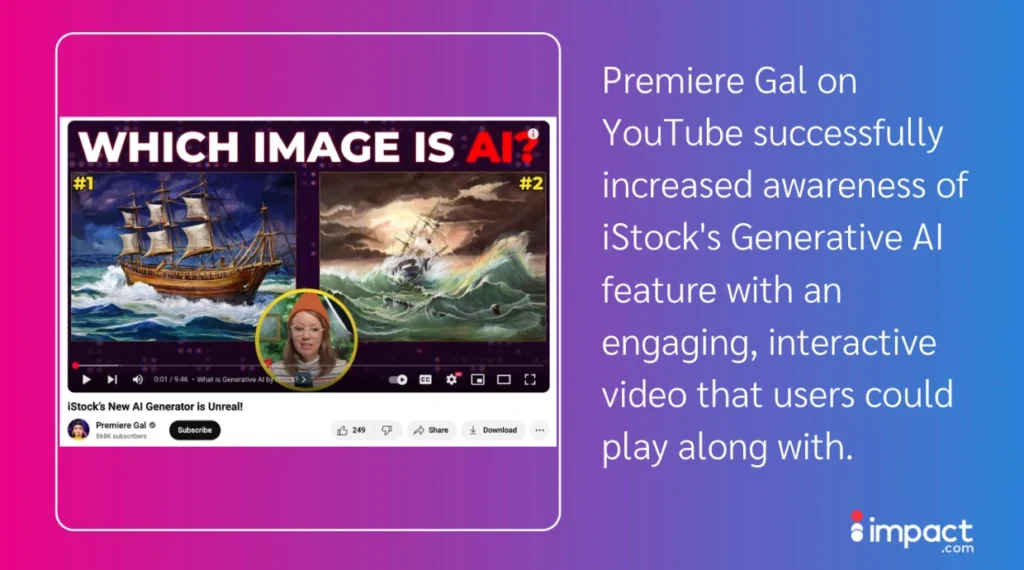
Premiere Gal produced an engaging, interactive video to showcase iStock’s Generative AI feature and highlight its functionality in a fun and compelling way.
The right payment terms help brands achieve campaign goals
Choosing a suitable payment model is key to the success of your content creator partnerships. Different creators might have varying compensation preferences, highlighting the importance of flexibility and open dialogue between brands and their partners.
impact.com’s research underscores the need for brands to discuss and negotiate with creators rather than presenting take-it-or-leave-it offers.
Fair compensation is more important than ever––43 percent of creators report they would end a collaboration if the pay didn’t meet their expectations, and 40 percent indicate that attractive compensation is a strong incentive for committing to long-term partnerships.
Fostering open communication and negotiating terms that benefit both parties sets the stage for a powerful collaboration. Starting on the right foot motivates creators and aligns their goals with yours, especially if there’s potential for lucrative earnings, such as performance-based incentives.
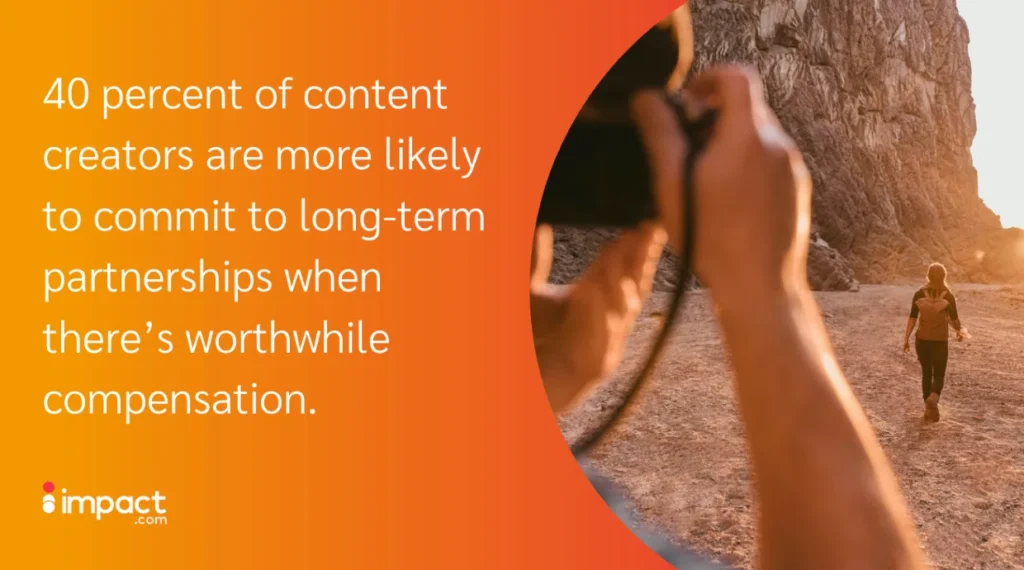
Content creators are driven by competitive compensation, with 40 percent stating they are more likely to commit to long-term partnerships when the payment aligns with their expectations.
7 most popular payment methods for content creators
Partnering with the right creators will get your brand in front of new audiences and drive higher engagement.
But, how you compensate creators can significantly impact the success of your collaboration. When choosing how to pay content creators, consider your program’s scope, overall goals, and budget.
Your chosen payment model is more than handing over a paycheck, though––it must align with your brand’s goals and the content creator’s expectations.
Be transparent: 80 percent of creators consider clear communication about compensation important. Remember that content creators provide a high-quality service that can make or break your campaign, so consider their needs and compensate them fairly, especially if you want to build a long-term relationship.
Explore the seven effective methods for compensating content creators:
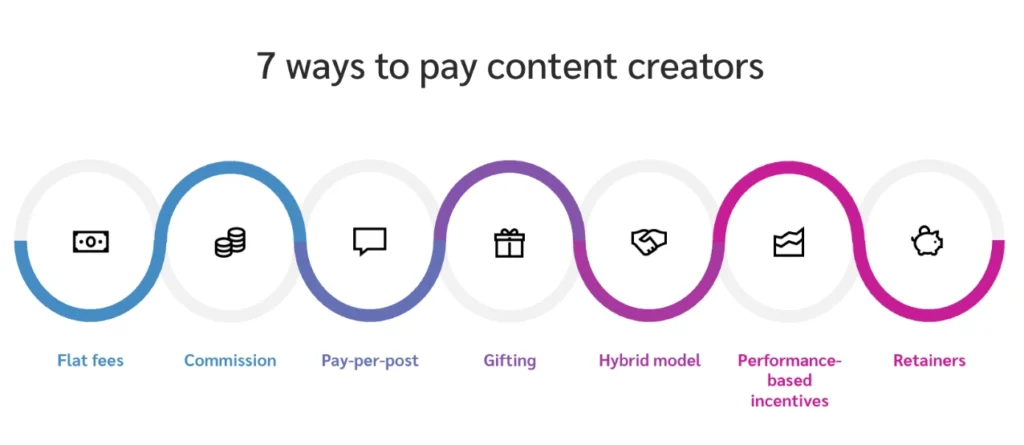
- Flat fees
- Commission
- Pay-per-post
- Gifting
- Hybrid model
- Performance-based incentives
- Retainers
#1 Flat fees take the pressure off content creators
One of the simplest ways to collaborate with creators is through a flat fee agreement. In this payment model, you pay the content creator a fixed amount regardless of campaign performance.
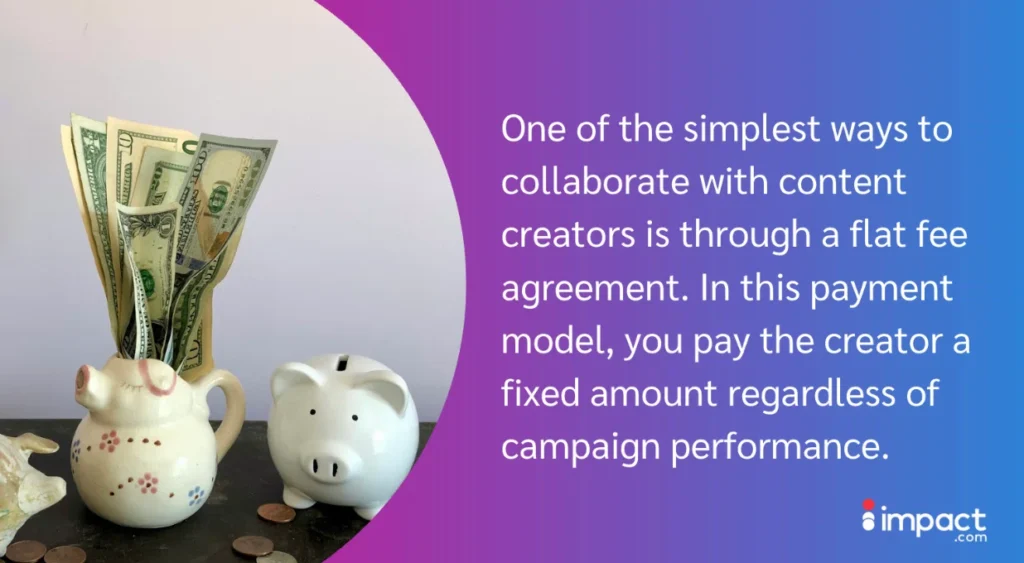
According to impact.com’s research, most creators prefer this payment model when they team up with a brand for the first time. It lets them build trust without the pressure of hitting performance metrics.
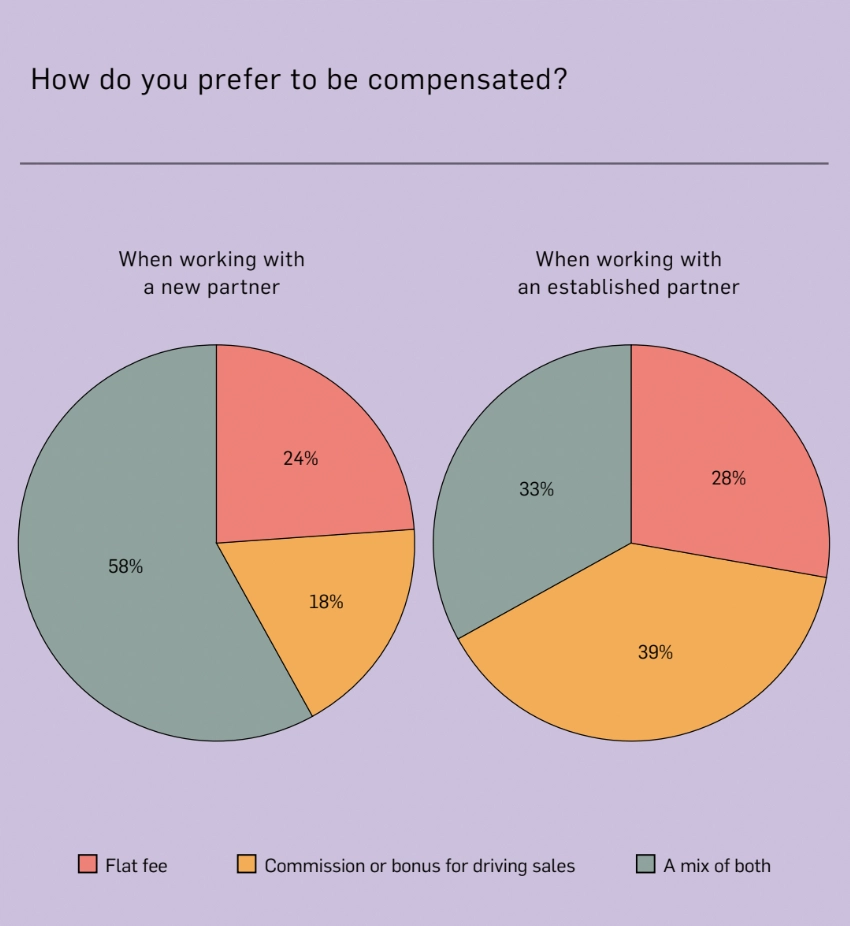
A snippet from Ghosted no more: The secrets to thriving creator-brand partnerships.
Things to consider:
- Flat fees foster predictable budgets.
- The brand and creator should set clear expectations from the get-go.
- Content creators must receive a scope of work and outlined deliverables before creating.
Flat fees are perfect for:
- Established brands with clear campaign objectives and budgets.
- Product launches or promotional events where there is little room for error.
- Brands in consumer electronics, fashion, and beauty sectors.
#2 Commissions encourage mutually beneficial partnerships
Commission-based payment models allow content creators to earn a percentage of sales or leads generated from their promotional efforts.
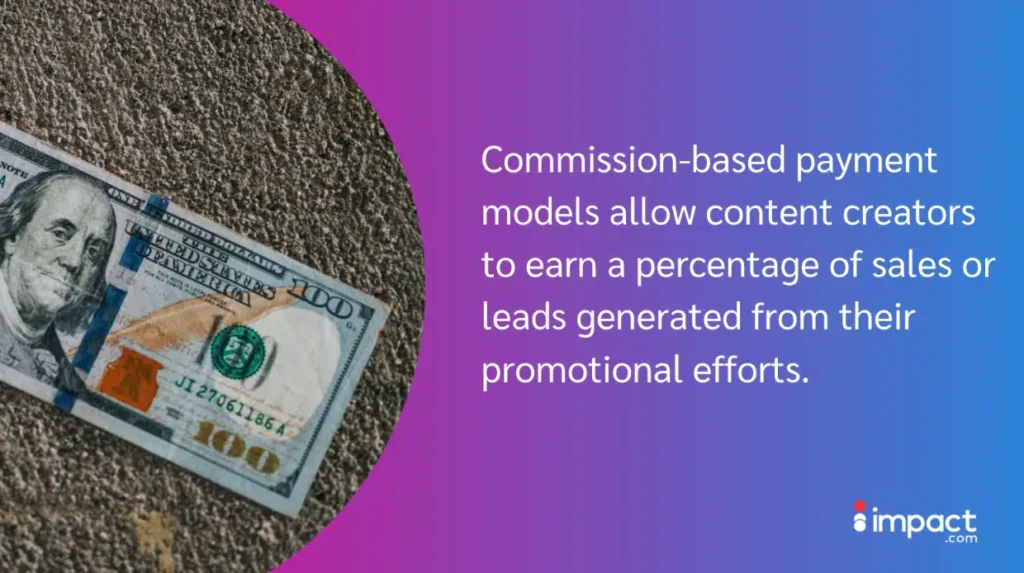
The commission model is your go-to if you want to tie content creator compensation directly to the results they drive. It allows your brand to reward performance, making it a win-win for brands and partners.
Things to consider:
- Content creators earn a percentage of the sales or leads generated.
- Commission motivates partners to maximize their impact.
- This model aligns the content creator’s efforts with your brand’s objectives.
- Real-time tracking features, like impact.com’s Performance by Creator tool, provide detailed insights into performance and allow you to accurately attribute commissions to your highest-performing partners.
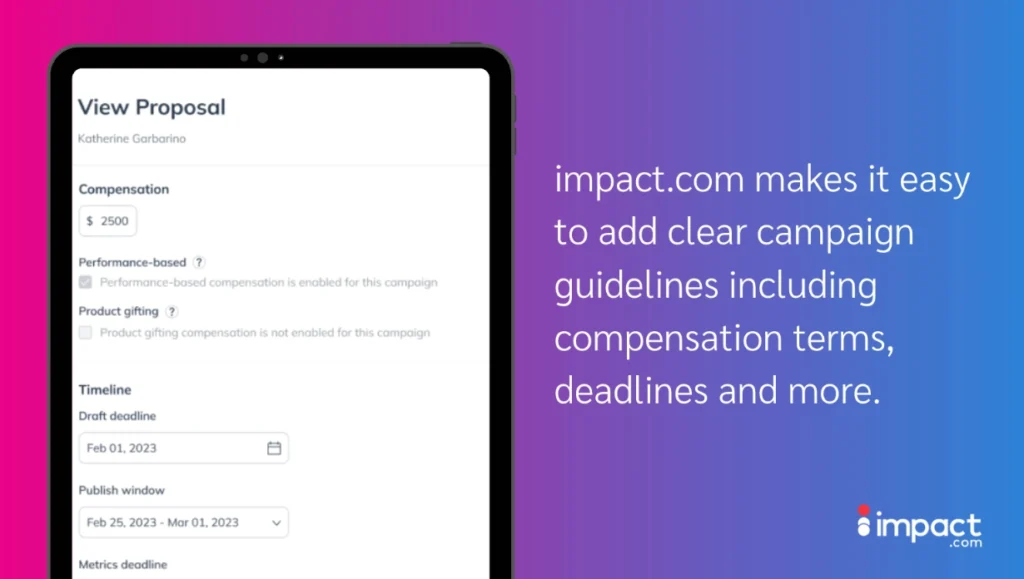
impact.com enables you to create tailored proposals for potential partners, allowing you to customize compensation plans and set clear deadlines with ease.
Commissions are perfect for:
- E-commerce platforms and online services looking to drive sales or subscriptions.
- Relationships where the content creator has a proven track record and deep trust with their audience, so they have a better chance of conversion.
- Brands that are confident in their product and want to drive sales.
- Businesses keen on maximizing return on investment (ROI).
#3 Gifting enhances brand exposure (without a hefty investment)
Gifting is when brands offer creators their products or services as payment. Creators usually review these products or services in authentic UGC posts.
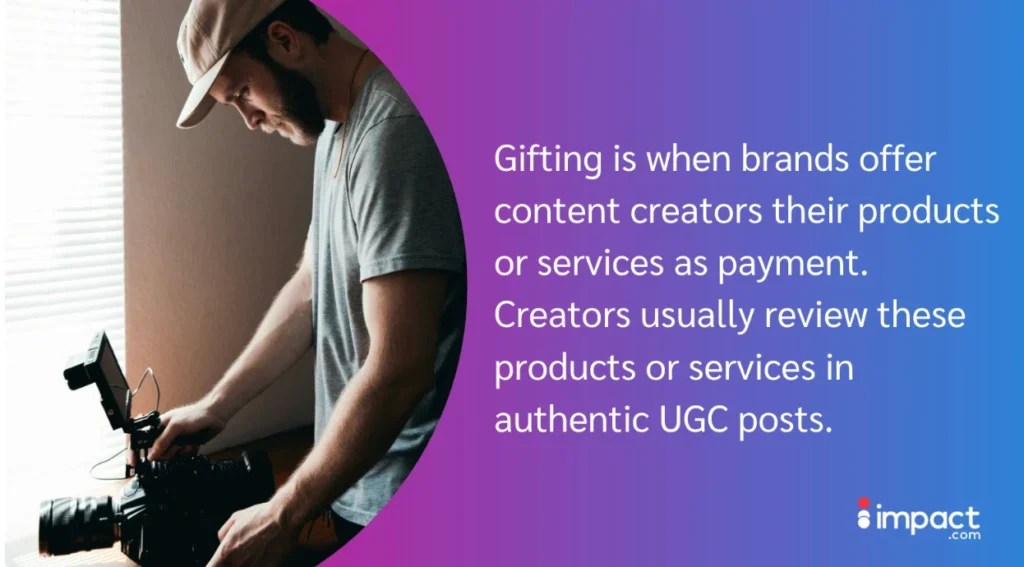
Resident, the company behind Nectar Sleep and DreamCloud, proves gifting works
The brand successfully expanded its creator program by gifting luxury mattresses to lifestyle creators, encouraging authentic content across the entire buyer journey—from awareness and consideration to decision-making and retention.
The results speak volumes:
- Higher ROI: Creator-generated ads achieved 1.08 ROAS vs. 0.89 for traditional produced ads
- Cost efficiency: Profitable campaigns using only gifted products (no cash payments)
- Content multiplication: Doubled the impact of each post through strategic repurposing across paid media
“Diversifying our content and the creators we worked with helped us optimize our program.” — Jennifer Bentz, VP of Affiliates, Resident Home
This method suits brands with tangible products seeking authentic endorsements and cost-effective content creation.
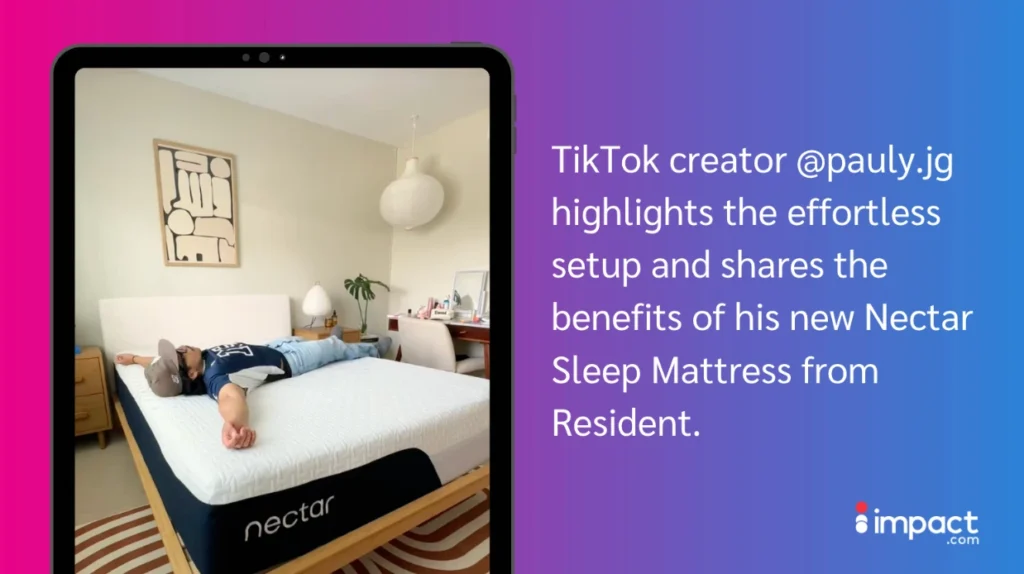
TikTok creator @pauly.jg collaborates with Nectar Sleep as a brand partner. In return for a complimentary mattress, he crafts engaging and impactful content to promote Resident’s Nectar Sleep brand.
This method suits new or niche brands seeking exposure and credibility using creator content.
If you decide to use gifting as compensation, it’s best to proceed with caution––some creators may not appreciate the offer of gifts or discounts in place of flat fees or commissions.
As one creator told us: “Big turn off: discounted product/services vs free and paid to promote.” Free gifts don’t pay the bills for creators, so always consider adding a fee or commission in addition to gifts.

Things to consider:
- Gifting is an excellent way to gain visibility without a significant upfront investment.
- It encourages creators to experience and share your product authentically.
- Some creators may not be open to gifting, and most want to receive a fee in addition to gifts.
Gifting is perfect for:
- Startups and small businesses with limited marketing budgets or established brands (such as Coach) that are looking to create engagement.
- Brands in the beauty, tech, and specialty foods sectors, where product experience and endorsement significantly influence consumer decisions.
#4 Pay-per-post gives you room to test engagement rates and overall performance
A pay-per-post model can be the perfect fit when you want to engage your partnerships. This approach compensates content creators for each piece of content—a post, story, or video—featuring your brand.
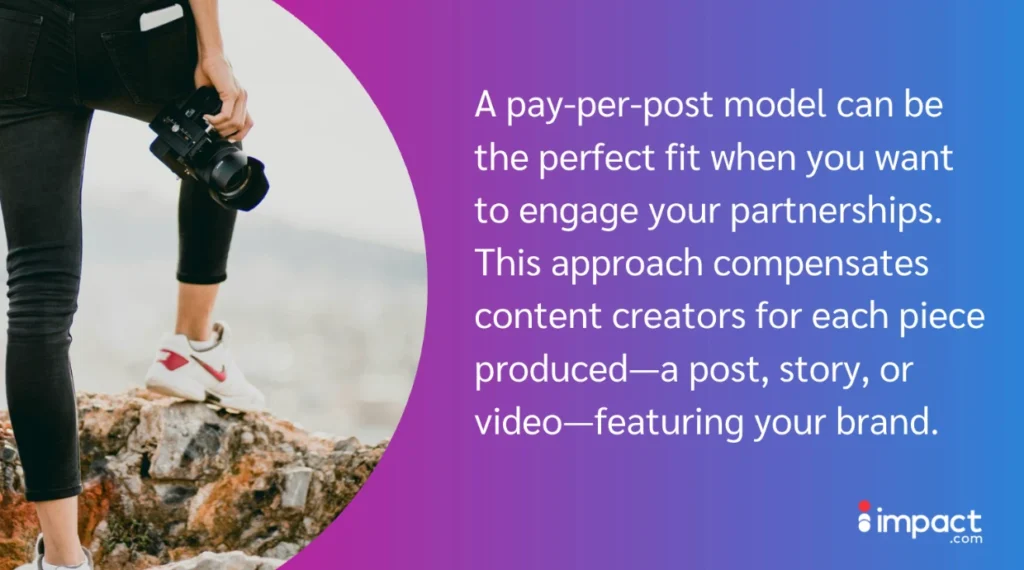
Things to consider:
- Pay-per-post is an effective model for campaigns focused on content creation across various platforms.
- It provides a clear structure for planning and budgeting.
- It’s great for testing a creator’s performance and adding more posts as you go.
- Creators feel incentivized to deliver on time and bring leads.
Pay-per-post is perfect for:
- New or emerging brands aiming to build awareness across multiple channels.
- Brands that prefer a flexible approach to content creation and platform selection.
- Lifestyle, health and wellness, and food and beverage brands, where engagement across diverse channels is a priority.
#5 The hybrid model: a brand and creator favorite
You don’t have to choose between a flat fee and performance-based pay. Why not have the best of both worlds? The hybrid model does exactly that, blending a guaranteed payment with the potential for additional earnings based on performance.

Hybrid payment models give creators the best of both worlds: guaranteed income plus performance upside. More than 4 out of 5 creators say they appreciate performance bonuses and commissions, but they prefer these combined with a flat fee for stability. This balanced approach helps brands build stronger, more productive creator relationships.
The challenge is that many brands struggle to track and pay creators effectively, especially when managing them as affiliates or across different partner types. Without the right technology, ensuring accurate and timely payments becomes a logistical nightmare.
How impact.com simplifies hybrid payments
That’s where impact.com comes in. Our platform makes hybrid payments seamless through:
- Flexible payment structures — combine flat fees, commissions, or both
- Automated tracking — accurate attribution across all partner types
- On-time payments — reliable payouts that build creator trust
- Unified management — handle content creators and affiliates in one platform
The creator-affiliate convergence trend
Merging creators and affiliates is transforming partnerships in 2025. This hybrid approach delivers multiple benefits:
✓ Measurable results — creators drive trackable sales and leads
✓ Authentic promotion — performance incentives encourage genuine brand advocacy
✓ Scalable growth — creators become true business partners, not just content producers
✓ Win-win outcomes — brands get ROI, creators get sustainable income
This strategy transforms creators from one-time collaborators into invested brand partners who are motivated to drive real business results.
Watch the webinar, Unlocking the Power of Affiliate and Influencer Marketing for Full-Funnel Dominance, to get the full story on targeting the entire customer journey.
Things to consider:
- Additional earnings depend on performance metrics, including engagement rates, conversions, or sales.
- The potential for additional earnings is a strong incentive for partners to create content that truly resonates with their audience.
- The hybrid model allows brands to budget their campaigns while rewarding creators for top performance.
Hybrid models are perfect for:
- Brands with different levels of collaborations, from micro- to mega-influencers.
- Companies in competitive markets such as fashion, beauty, and gaming, where incentivizing partners to exceed performance metrics can lead to higher engagement and conversions.
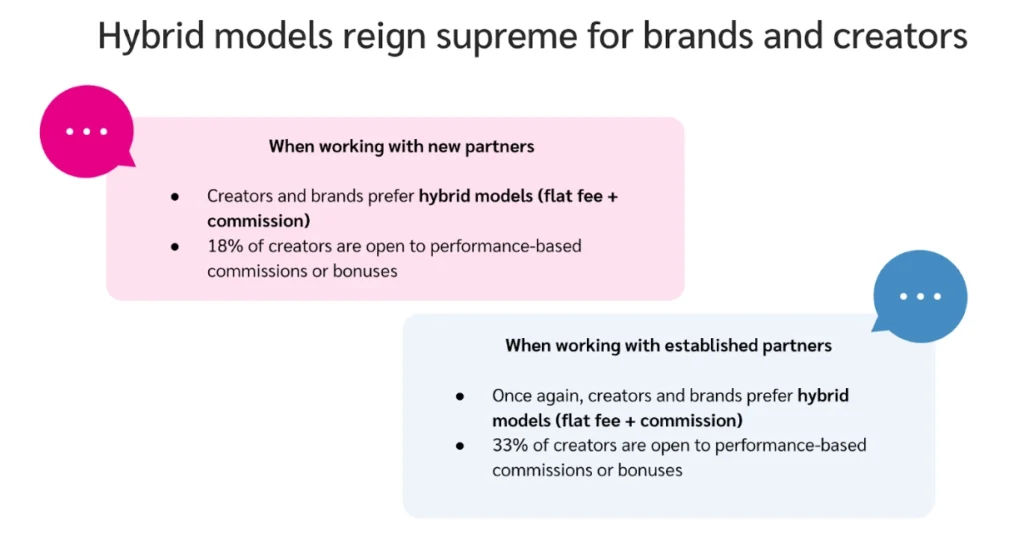
Based on impact.com’s research, this diagram highlights hybrid compensation models as the fan favorite for brands and creators—whether they’re new or established partners.
#6 Performance-based models can boost content quality
Performance-based incentives reward content creators for surpassing specific targets or milestones. These targets may include exceeding a sales threshold or achieving a high engagement rate.
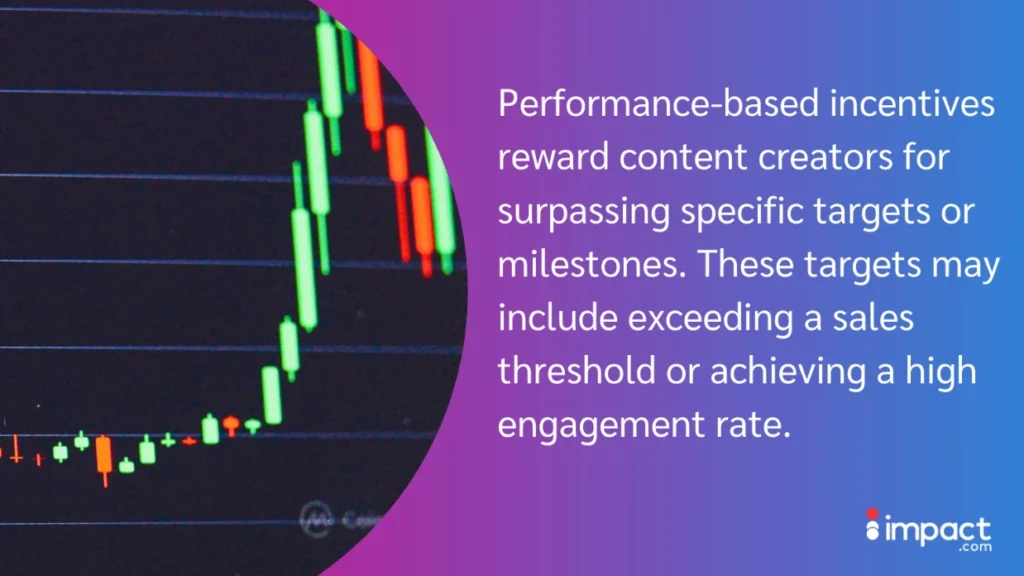
Things to consider:
- Bonuses can motivate creators to put in their best effort.
- This effort can elevate content quality and result in better outcomes for the brand.
- Many partners like the stability of a flat fee combined with commission.
Performance-based incentives are perfect for:
- Brands looking to motivate creators to surpass campaign goals.
- Seasonal or peak sales periods, including holidays for retail brands and product launch phases for technology companies.
#7 Retainers nurture long-term partnerships
Retainers are great payment models for brands ready to cultivate long-term creator partnerships. Paying partners a monthly retainer helps them maintain their ongoing commitment to promoting the brand.
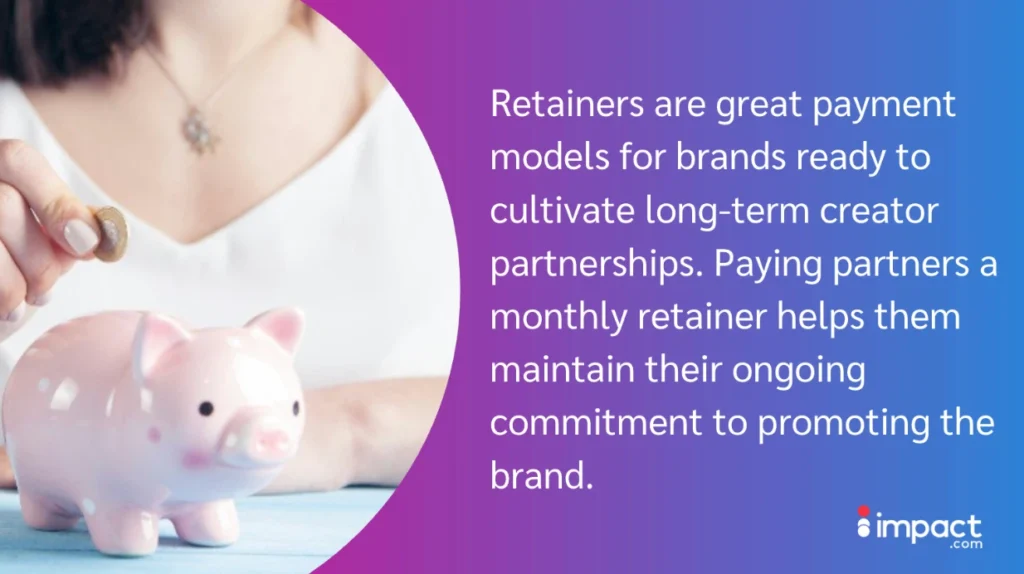
Things to consider:
- Retainer models encourage a deeper partnership, allowing content creators to become true ambassadors for the brand over time.
- Brands can budget for retainers for a specific period without any added costs.
- Creators gain financial security, knowing what they will earn each month.
Retainer models are perfect for:
- Brands seeking long-term advocacy and deeper partnerships with creators.
- Industries where consistent brand representation plays a critical role, including luxury goods, automotive, and high-end lifestyle services.
FAQs
Content creators typically get paid through brand partnerships, where companies compensate them for promoting products or services on their platforms. Payment can come in the form of fixed fees, which are negotiated based on audience size, engagement rates, and niche. Some creators earn through affiliate marketing, receiving commissions for sales made using their unique links or discount codes. Others may be compensated with free products, services, or event invitations instead of monetary payment, especially for smaller collaborations.
The most popular method of compensation for content creators is monetary payment, often in the form of a flat fee per post or campaign. This allows brands to directly pay creators based on their reach, engagement, and niche. Other common methods include free products or services, affiliate commissions, and performance-based payments tied to sales or leads generated. Ultimately, compensation depends on the brand’s goals, the creator’s audience size, and the nature of the collaboration.
The number of followers you need to be a paid content creator depends on the platform, niche, and type of brands you work with. Generally, nano-influencers (less than 15k) and micro-influencers (15-75k followers) can still earn money by partnering with niche brands, especially if their audience is engaged and targeted. Larger creators with 100k+ followers often command higher fees due to their broader reach, but engagement rates are equally important. Ultimately, it’s less about the follower count and more about your ability to connect with your audience and deliver results for brands.
Hybrid payment models work best for most brands. Combine a guaranteed flat fee (for creator security) with performance-based commissions (for motivation). Research shows 80% of creators prefer this approach because it provides income stability while rewarding strong performance.
Most established creators prefer monetary compensation. While 93% are willing to work for free products if they love the brand, surveys show creators increasingly expect cash payments for professional collaborations. Gifting works best for product-focused niches like beauty, tech, and home goods.
Fair compensation fosters long-term partnerships and compelling content
Now that you understand the seven types of content creator compensation models, it’s time to choose the right one for your brand.
More and more brands are turning to hybrid payment models, and for good reason—they motivate creators to deliver their best work while keeping your budget predictable. With impact.com, you can seamlessly implement and customize hybrid payments, combining multiple payment methods to fit your needs.
As you build creator partnerships, trust impact.com to provide the tools to maximize your campaigns with flexible, effective payment structures.
Ready to build successful long-term partnerships with creators? Schedule a demo today and take a look at our ultimate guide to influencer tiers ebook.







